How much will it cost to build your retirement home in the Philippines? In this post I will address how much it might cost for you to build your own residence on this archipelago of 7,107 islands. But keep in mind there is absolutely no way I can predict how much it might personally cost future expats to build a new home in the PH, this post is merely drawn upon my own personal experiences and online research.
Our new residence is being manufactured in the rural island province of Guimaras, located in Western Visayas. Location and time of year are two factors to be considered when planning your own building project. A recent comment from a faithful reader, Jason B, prompted me to post this article. Thanks for the comment, Jason, and thanks for your support.
We started manufacturing our domicile in January 2015. Our rainy season ends in November. The months of February through May are the prime time building months in our region. Heavy monsoon rains from June until November, with rainfalls up to 18 inches in August, make it extremely difficult to build a new home and will certainly result in delays. During our entire construction phase thus far, we’ve only had a half-day delay due to rain.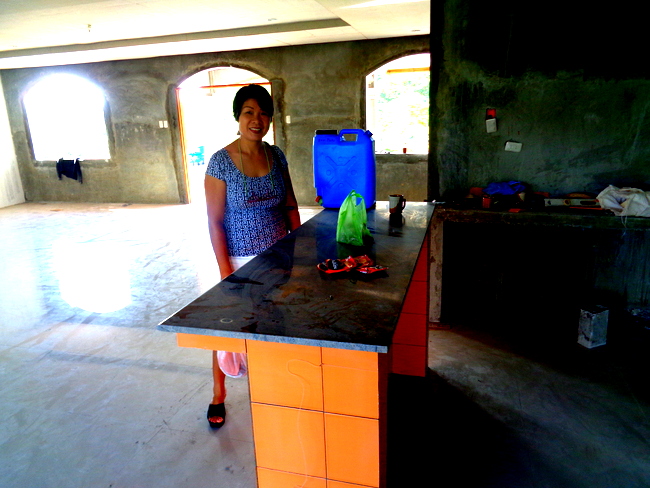
(My lovely asawa stands by our new granite top island in the kitchen area.)
But as the summer months of March, April and May approached, the price of building materials in our region increased, due to increased construction on our island province during this time. It’s a classic case of supply and demand.
A bag of cement cost 252 pesos (5.63 US Dollars) in January. Now the price has gone up, ten pesos, to 262, $5.85. We’ve used well over 800 bags of cement thus far (a conservative estimate.) 800 bags would now cost us 176 dollars. Not a huge difference, but add up the additional costs for other building materials and it does inflate our budget somewhat.
How much would it cost for you to build your own home in the Philippines? Location, as mentioned at the beginning of this post, is another component to consider. Those expats building in the NCR, National Capital Region, Metro Manila, might find your material costs somewhat cheaper than what we experience in Guimaras. My research shows the aforementioned bag of cement selling for around 200 pesos in the NCR, 4.47 USD. 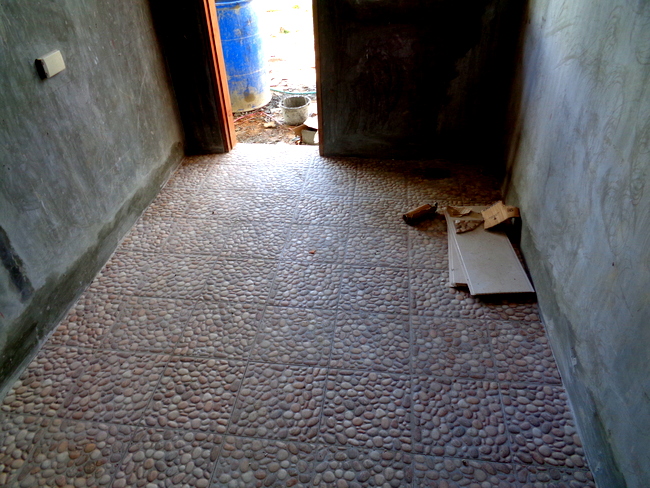
(Most of the tile work in our new home has been completed. Here’s a look at the floor of our laundry room.)
If you live in the Metro area and can give me a more accurate price for a bag of cement, or any other vital construction material, it would be appreciated.
My asawa and I have a brother-in-law in the Metro Manila area of Caloocan who has been selling construction materials for years. While we could have purchased materials from him, it would have been a wash, as shipping the materials to Guimaras would have erased any possible savings we could have gained by buying from our relative.
It has been much easier to buy our material from our own island province or nearby Iloilo City on Panay Island. Some material, such as our roof, had to be purchased and shipped from Cebu.
You could build your own expat home in Guimaras for as little as 4,000 US Dollars. Or you could spend five million pesos, over 110,000 USD, (or more) for your new homestead. I know of expats on our island province who have done both. My father-in-law’s nipa hut on our property was built for 2,000 USD and could comfortably accommodate two people.
Our 3,000 square foot home, replete with a 1,700 living room/dining room/kitchen open floor plan, with four bedrooms and four CR’s, comfort rooms, currently is coming in at approximately a little over 70,000 dollars. Could we have built a new home the same size in the United States for that price? Doubtful.

The United States Census Bureau in 2010 puts the cost per square foot of a single-family home in the Midwest at $85.24. Thus, a 3,000 square foot house such as we are building could have cost $255,000 and that’s according to figures five years ago.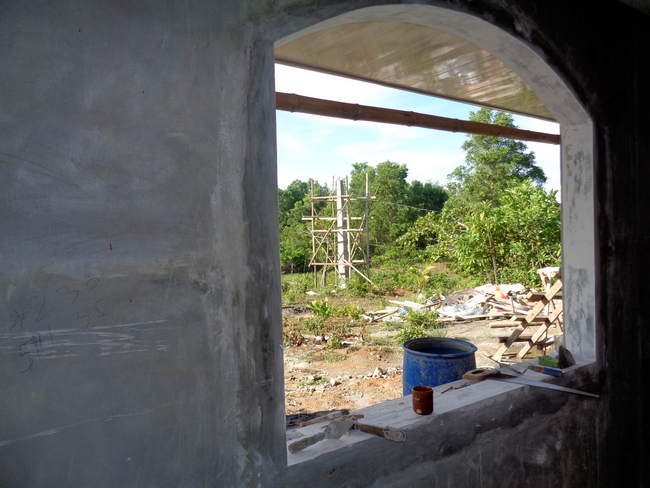
(A skim coat has been applied to all of the windows. Next, another coat of paint, flat white latex, will be applied. After the inside of all the windows have been painted, the installers from Guimaras Glass will put in all of our windows.)
However, according to “Build Your Own House,” by Carl Heldmann, it would now cost 319,000 USD to build a house, 1,900 square foot home in Kankakee, Illinois (I’m originally from Central Illinois.) By his estimate of square footage for the Illinois project, a 3,000 square foot home would cost $500,000, if I’ve done my math correctly.
Either way, I am convinced, that for the most part, we would have had a difficult time building a 3,000 sq. ft. house in the Philippines for the equivalent cost in Central Illinois. I am neither a builder or construction expert, like some of my readers, Bill S, for example. Mine is only a somewhat educated guess, again based upon my own personal experiences.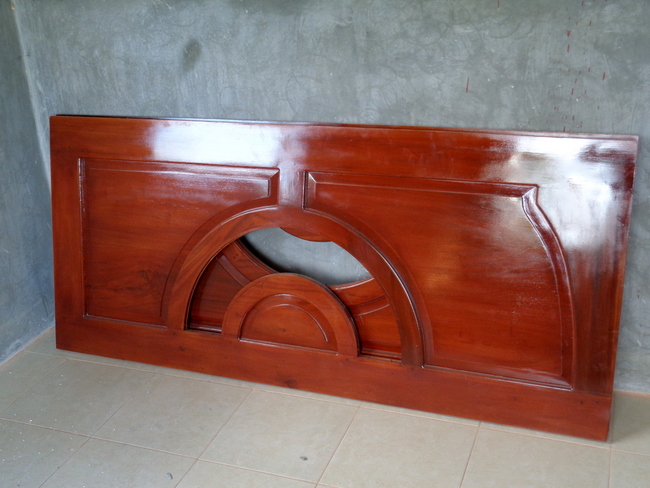
(Here’s a peek at the custom front door. Glass inserts are being manufactured for the door.)
Here’s our pay scale for each worker:
Joery, foreman for our nipa hut and dirty kitchen: 400 pesos a day, 9 USD
Laborer: 300 pesos a day, 6.70 USD
Carpenter: 350 pesos a day, 7.80 USD.
The workers are also provided two meriendas (snacks) a day but no lunch. While these wages are extremely low compared to what workers in the United States earn, they are a fair wage for our island province and one reason while it is much cheaper to build a new home in the Philippines than in a Western country.
Do workers in the Metro Manila area earn more? I would leave that question to Derek, or Scott H, and other readers that live in the Metro. When Scott H had his dream home in Paranaque built a couple of years ago, he was paying his laborers 310 pesos a day and his foreman 900 pesos a day. We were paying our main foreman, Boy, 600 pesos a day, but Boy is now working on a per job basis (installing the tiles now) and he is paying his crew out of the fee for that job.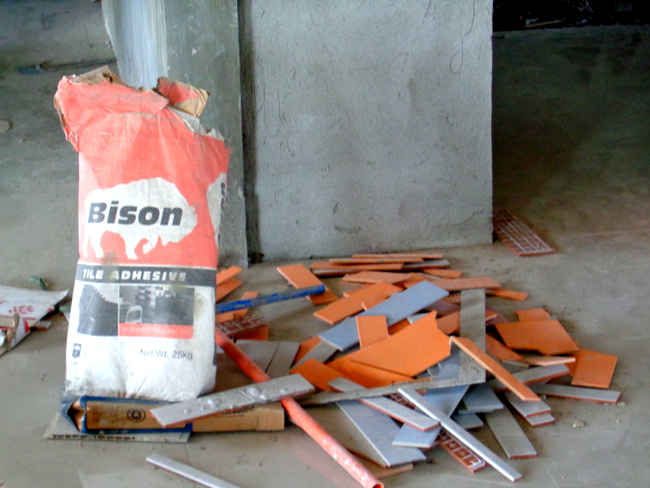
(Bison brand tile adhesive is being used for the floor tiles.)
If I would venture a guess, I would estimate it might take another 300,000 pesos, around 7,000 USD, to complete our home. We will always have future projects, like our new swimming pool, which will begin around November or December of this year, after the end of the rainy season. There will be plenty of landscaping projects and other details that will keep everyone busy even after we move in.
It’s been a busy time for us down at “The Farm,” our present location in Guimaras. I’ve begun packing some boxes and getting things in place for the big move. But at least this move will not involve going from one island to another as was the case when we moved from Iloilo on nearby Panay Island, to our present location. And we now have a truck which will greatly assist us in the move.
We will be purchasing new appliances and furniture once our new home in the Philippines is completed. Doesn’t make sense to buy everything now and move it again.
Feel free, if you like, to share what your retirement home in the Philippines has cost you. Of course, that’s a personal topic for many people but any information shared on this site could potentially help other expats and future expats like Jason and would be appreciated. Thanks in advance.
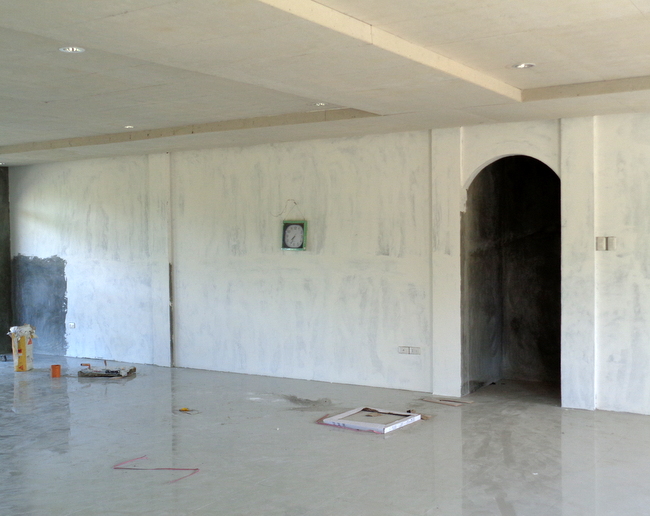
the wharf we used to take boat to natago is right next to that new 200 room hotel that the chineese investor is building, have you seen the place yet? Anyway the place is massive and according to the people I was with it is pissing off the locals because they cant get building supplies such as sand for concrete and so on. Also the locals are upset due to all the water that’s going to be used from the ground water table to run this place which has 2 pools under construction. This hotel is supposedly geared towards the Chinese as the mayor also has a big fiberglass boat moored out front of the hotel, this boat seats around 20 passenders with individual seats and is powered by 2 huge 200 horsepower outboard engines. The boat will be used to ferry passengers back and forth to the hotel from Iloilo bypassing to slow Bangka boats and the 45 minute trip by van to the hotel. I am not sure which mayor is involved, argo may know more about this.
Hi Dave, you’re house is looking good I like that front door looks quality,here in Manila
1 bag of cement will cost about 220 pesos the price will get lower if you buy in bulk
We pay our workers about 400 pesos a day carpenters 500 pesos a day,we have a guy
Working now who can do plumbing carpentry welding and roofing we pay 500 pesos a
Day, we give them lunch and 2 meriendas biscuits or cake for there breaks , we try to
Look after them it’s not a lot of money to us but to them it’s their living, another thing is
Price of the land your going to build your dream home on we bought our land for about
8 thousand pesos a square meter about 10 years ago now it’s 15 thousand a square
Meter now our land is only 250 square meters but it’s still a lot of money compared with
What you can buy in the province,so Dave you’ve got it made there in guimaras
Derek in sunny pasig , just going to have a cold one its been a hot day
It would be very interesting to know how much it would cost to build your house here in the US, using the same building types of construction materials you used there. Of course everything would have to be brought up to building codes here, so I am guessing that alone would add a minimum of 25% or more to the costs. Concrete block, concrete and steel are not the norm for here, instead of wood would also add very significantly to the cost over a standard stud wall construction.
I have read articles that differ, but here labor is apx. 67% of the cost for building and materials are the other 33%, but that depends also on the area of the US.
Totally a guess, but I think in my area your house would be up around the $115.00-130.00 psf. cost. mainly because of it being all masonry construction, ( I am trying to compare apples to apples for the same type of construction) Your window and door fascias, made out of concrete, they would all have to be custom made for each opening, I believe they alone could reach upwards of $80,000.00 here , just because of the specialized craftmanship it would require here. Here we would use wood, or Fypon mouldings (Styrofoam) to keep the costs down somewhat, but they would still have to be custom made pieces.
Like there, prices differ widely depending on area and many other variables.
In my opinion, that is a GREAT price, but then I am not the least bit familiar with prices there. My very small amount of research I have done there, I do think it would cost more to have built your house in the Davao area, but thats a highly Un-educated GUESS!
Hello Dave:
looks like things are moving along nice on your new house i’m sure you and your asawa our excited about getting it finished and moving.
as far as the cost of building in the philippines I have to agree it has a lot to do with location your building , time of year, cost of material, size and style. not only is a house build much cheeper in the philippines then in the states the construction process is much different . can you imagine the cost of building a house in the states with all cement and steel. also add in a custom built kitchen cabinets, doors and all tile floors.
control of the build is a must. also you must be in charge of all material purchase and paying of your workers and have eyes on build sight. I can pretty much promise if you hire a lead builder (“contractor”) in the philippines if they think they can build they will call them self contractors. but if you give someone full control over your build chances are it is going to take a lot longer to get finished if it gets finished at all. and the cost will be at least double.
bottom line you can spend as much or as little as you want “BUT IT IS A MUST THAT YOUR IN FULL CONTROL OF THE BUILD”
Dave, looks like the Philippines is following other countries in allowing residences to sell excess solar energy back to their electrical company:
http://www.rappler.com/business/industries/173-power-and-energy/64165-solar-power-ph-households-net-metering
Maybe you could move the solar powered light to the bathroom instead then, in case there is an evening brownout
Dave,
When you start packing you know the move is close. Everything is relevant, but overall it sounds like a pretty good deal and you can never do that in the US. Looking to seeing it in person.
Also, a guy in one of the blogs on FB is building a small house for $5,000USD in Oton, Iloilo. One Room. Just a little too small for me.
FFS. You’ll appreciate this Iloilo scenario Dave! Half in the bag, power goes out… Ok, no prob, sleep it off. BANGity bang bang bang! Cat falls though apparently UV damaged skylight. All frickin’ hell ensues, He breaks through skylight into pantry and dishes / goods / etc. everywhere. Light candles, get the cat out of the house and eventually block skylight with cardboard. Yay! Unless it rains tonight…. 🙂
Yes, had it repaired the same day. Same type skylight as yours, just was older and UV damaged (something you may have to worry about in 20 years maybe).
Yes, more rain coming FINALLY 🙂
Your costs sounds about right compared to what we spent to build our home in Digos, Mindanao. Although I think you did a much better job than us, as we were not present during the construction.
hope you enjoyed your trip to cebu. sounds like move in day is getting close…
Thank you so much Dave. I love your blog!!!! It helps so much!!!!
I always look forward to the stories and updates on your house. My Asawa and I had a two story dwelling built in Bacoor, Cavite back in 2009-2010 which cost us the equivalent of $57,000.00 it is a five bedroom, three CR cinder block house and it has served us well. My brother-in-law oversaw the build and lives in it and we stay there when we visit. My wife and I are contemplating the big “move” after I retire in a few more years but have yet to make up our minds for sure. My wife has lived here in the states since 1978 so almost all of her habits and routines are Americanized so we’re not sure we will be totally happy living there on a full time basis, we may make a couple of 6 month trips to “test” and see if it is what we truly want. I am all for it with the exception of missing immediate family and if we do, we plan to build again this time I could be on site nearly every day, and I think that would be quite an adventure. Good luck wrapping up your final major work and definitely enjoy the fruits of your labor.